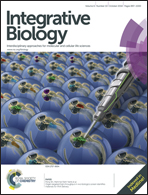Combinative in vitro studies and computational model to predict 3D cell migration response to drug insult†
Abstract
The development of drugs to counter diseases related to cell migration has resulted in a multi-billion dollar endeavor. Unfortunately, few drugs have emerged from this effort highlighting the need for new methods to enhance assays to study, analyze and control cell migration. In response to this complex process, computational models have emerged as potent tools to describe migration providing a high throughput and low cost method. However, most models are unable to predict migration response to drug with direct application to in vitro experiments. In addition to this, no model to date has attempted to describe migration in response to drugs while incorporating simultaneously protein signaling, proteolytic activity, and 3D culture. In this paper, we describe an integrated computational approach, in conjunction with in vitro observations, to serve as a platform to accurately predict migration in 3D matrices incorporating the function of matrix metalloproteinases (MMPs) and their interaction with the Extracellular signal-related kinase (ERK) signaling pathway. Our results provide biological insight into how matrix density, MMP activity, integrin adhesions, and p-ERK expression all affect speed and persistence in 3D. Predictions from the model provide insight toward improving drug combinations to more effectively reduce both speed and persistence during migration and the role of integrin adhesions in motility. In this way our integrated platform provides future potential to streamline and improve throughput toward the testing and development of migration targeting drugs with tangible application to current in vitro assays.


 Please wait while we load your content...
Please wait while we load your content...